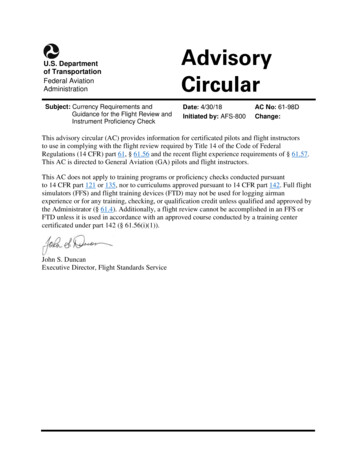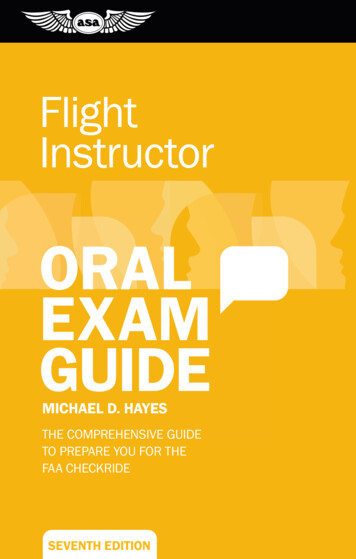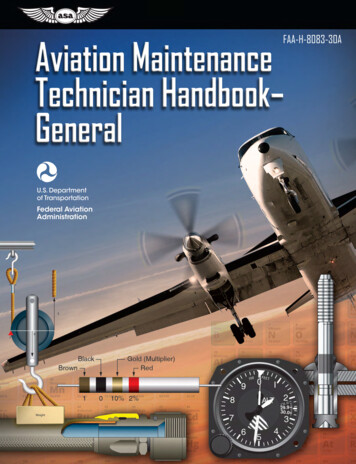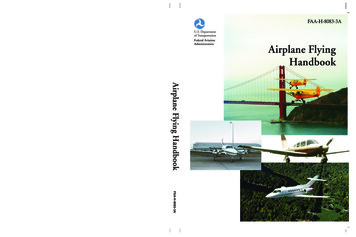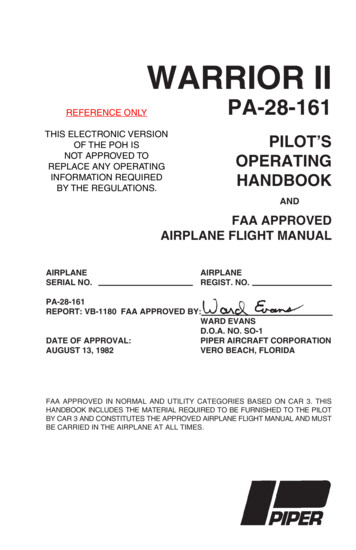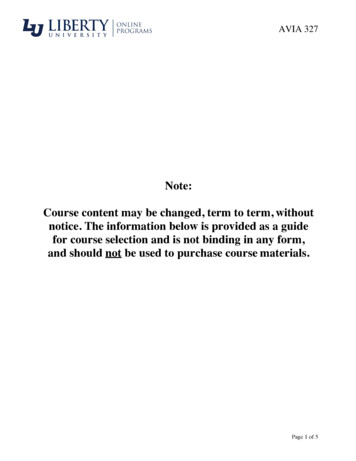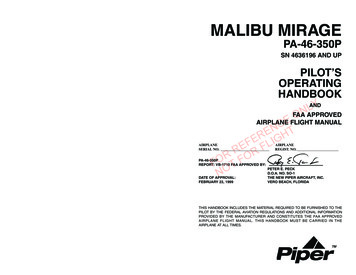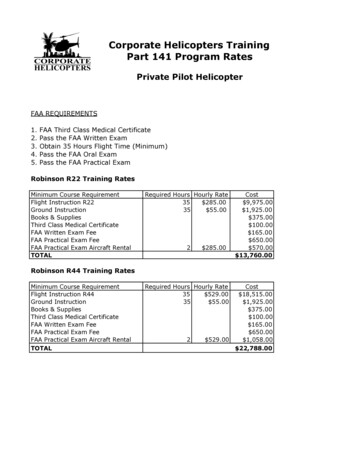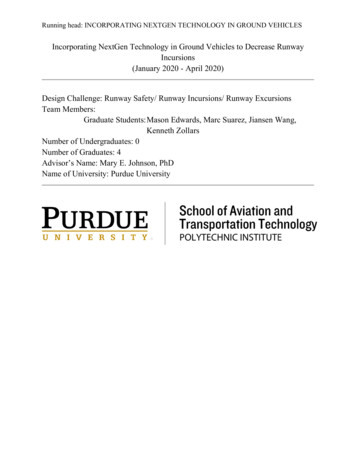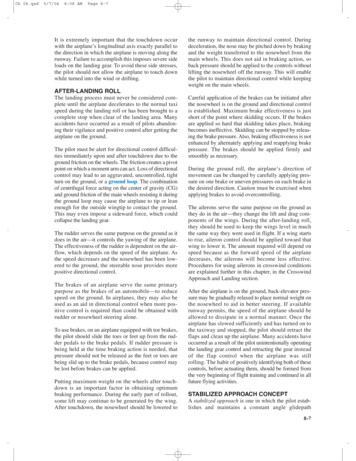
Transcription
Ch 08.qxd5/7/048:08 AMPage 8-7It is extremely important that the touchdown occurwith the airplane’s longitudinal axis exactly parallel tothe direction in which the airplane is moving along therunway. Failure to accomplish this imposes severe sideloads on the landing gear. To avoid these side stresses,the pilot should not allow the airplane to touch downwhile turned into the wind or drifting.AFTER-LANDING ROLLThe landing process must never be considered complete until the airplane decelerates to the normal taxispeed during the landing roll or has been brought to acomplete stop when clear of the landing area. Manyaccidents have occurred as a result of pilots abandoning their vigilance and positive control after getting theairplane on the ground.The pilot must be alert for directional control difficulties immediately upon and after touchdown due to theground friction on the wheels. The friction creates a pivotpoint on which a moment arm can act. Loss of directionalcontrol may lead to an aggravated, uncontrolled, tightturn on the ground, or a ground loop. The combinationof centrifugal force acting on the center of gravity (CG)and ground friction of the main wheels resisting it duringthe ground loop may cause the airplane to tip or leanenough for the outside wingtip to contact the ground.This may even impose a sideward force, which couldcollapse the landing gear.The rudder serves the same purpose on the ground as itdoes in the air—it controls the yawing of the airplane.The effectiveness of the rudder is dependent on the airflow, which depends on the speed of the airplane. Asthe speed decreases and the nosewheel has been lowered to the ground, the steerable nose provides morepositive directional control.The brakes of an airplane serve the same primarypurpose as the brakes of an automobile—to reducespeed on the ground. In airplanes, they may also beused as an aid in directional control when more positive control is required than could be obtained withrudder or nosewheel steering alone.To use brakes, on an airplane equipped with toe brakes,the pilot should slide the toes or feet up from the rudder pedals to the brake pedals. If rudder pressure isbeing held at the time braking action is needed, thatpressure should not be released as the feet or toes arebeing slid up to the brake pedals, because control maybe lost before brakes can be applied.Putting maximum weight on the wheels after touchdown is an important factor in obtaining optimumbraking performance. During the early part of rollout,some lift may continue to be generated by the wing.After touchdown, the nosewheel should be lowered tothe runway to maintain directional control. Duringdeceleration, the nose may be pitched down by brakingand the weight transferred to the nosewheel from themain wheels. This does not aid in braking action, soback pressure should be applied to the controls withoutlifting the nosewheel off the runway. This will enablethe pilot to maintain directional control while keepingweight on the main wheels.Careful application of the brakes can be initiated afterthe nosewheel is on the ground and directional controlis established. Maximum brake effectiveness is justshort of the point where skidding occurs. If the brakesare applied so hard that skidding takes place, brakingbecomes ineffective. Skidding can be stopped by releasing the brake pressure. Also, braking effectiveness is notenhanced by alternately applying and reapplying brakepressure. The brakes should be applied firmly andsmoothly as necessary.During the ground roll, the airplane’s direction ofmovement can be changed by carefully applying pressure on one brake or uneven pressures on each brake inthe desired direction. Caution must be exercised whenapplying brakes to avoid overcontrolling.The ailerons serve the same purpose on the ground asthey do in the air—they change the lift and drag components of the wings. During the after-landing roll,they should be used to keep the wings level in muchthe same way they were used in flight. If a wing startsto rise, aileron control should be applied toward thatwing to lower it. The amount required will depend onspeed because as the forward speed of the airplanedecreases, the ailerons will become less effective.Procedures for using ailerons in crosswind conditionsare explained further in this chapter, in the CrosswindApproach and Landing section.After the airplane is on the ground, back-elevator pressure may be gradually relaxed to place normal weight onthe nosewheel to aid in better steering. If availablerunway permits, the speed of the airplane should beallowed to dissipate in a normal manner. Once theairplane has slowed sufficiently and has turned on tothe taxiway and stopped, the pilot should retract theflaps and clean up the airplane. Many accidents haveoccurred as a result of the pilot unintentionally operatingthe landing gear control and retracting the gear insteadof the flap control when the airplane was stillrolling. The habit of positively identifying both of thesecontrols, before actuating them, should be formed fromthe very beginning of flight training and continued in allfuture flying activities.STABILIZED APPROACH CONCEPTA stabilized approach is one in which the pilot establishes and maintains a constant angle glidepath8-7
Ch 08.qxd5/7/048:08 AMPage 8-8towards a predetermined point on the landing runway.It is based on the pilot’s judgment of certain visualclues, and depends on the maintenance of a constantfinal descent airspeed and configuration.An airplane descending on final approach at a constantrate and airspeed will be traveling in a straight linetoward a spot on the ground ahead. This spot will notbe the spot on which the airplane will touch down,because some float will inevitably occur during theroundout (flare). [Figure 8-9] Neither will it be the spottoward which the airplane’s nose is pointed, becausethe airplane is flying at a fairly high angle of attack,and the component of lift exerted parallel to the Earth’ssurface by the wings tends to carry the airplane forward horizontally.horizon appears to increase (aiming point movingdown away from the horizon), then the true aimingpoint, and subsequent touchdown point, is fartherdown the runway. If the distance between the perceived aiming point and the horizon decreases (aimingpoint moving up toward the horizon), the true aimingpoint is closer than perceived.When the airplane is established on final approach, theshape of the runway image also presents clues as towhat must be done to maintain a stabilized approachto a safe landing.A runway, obviously, is normally shaped in the formof an elongated rectangle. When viewed from theair during the approach, the phenomenon known asAiming Point (Descent Angle Intersects Ground)TouchdownDistance Traveled in FlareFigure 8-9. Stabilized approach.The point toward which the airplane is progressing istermed the “aiming point.” [Figure 8-9] It is the pointon the ground at which, if the airplane maintains aconstant glidepath, and was not flared for landing, itwould strike the ground. To a pilot moving straightahead toward an object, it appears to be stationary. Itdoes not “move.” This is how the aiming point can bedistinguished—it does not move. However, objects infront of and beyond the aiming point do appear to moveas the distance is closed, and they appear to move inopposite directions. During instruction in landings, oneof the most important skills a student pilot must acquireis how to use visual cues to accurately determine thetrue aiming point from any distance out on finalapproach. From this, the pilot will not only be able todetermine if the glidepath will result in an undershootor overshoot, but, taking into account float duringroundout, the pilot will be able to predict the touchdown point to within a very few feet.For a constant angle glidepath, the distance betweenthe horizon and the aiming point will remain constant.If a final approach descent has been established but thedistance between the perceived aiming point and the8-8perspective causes the runway to assume the shape ofa trapezoid with the far end looking narrower than theapproach end, and the edge lines converging ahead.If the airplane continues down the glidepath at aconstant angle (stabilized), the image the pilot seeswill still be trapezoidal but of proportionately largerdimensions. In other words, during a stabilizedapproach the runway shape does not change. [Figure8-10]If the approach becomes shallower, however, therunway will appear to shorten and become wider.Conversely, if the approach is steepened, the runway will appear to become longer and narrower.[Figure 8-11]The objective of a stabilized approach is to select anappropriate touchdown point on the runway, andadjust the glidepath so that the true aiming point andthe desired touchdown point basically coincide.Immediately after rolling out on final approach, thepilot should adjust the pitch attitude and power so thatthe airplane is descending directly toward the aimingpoint at the appropriate airspeed. The airplane should
Ch 08.qxd5/7/048:08 AMPage 8-9Too High3 Approach Angle4000' x 100' Runway1600' From Threshold105' AltitudeProper Descent AngleSame Runway, Same Approach Angle800' From Threshold52' AltitudeToo LowFigure 8-11. Change in runway shape if approach becomesnarrow or steep.Same Runway, Same Approach Angle400' From Threshold26' AltitudeFigure 8-10. Runway shape during stabilized approach.be in the landing configuration, and trimmed for“hands off” flight. With the approach set up in thismanner, the pilot will be free to devote full attentiontoward outside references. The pilot should not stare atany one place, but rather scan from one point toanother, such as from the aiming point to the horizon,to the trees and bushes along the runway, to an areawell short of the runway, and back to the aiming point.In this way, the pilot will be more apt to perceive adeviation from the desired glidepath, and whether ornot the airplane is proceeding directly toward theaiming point.If the pilot perceives any indication that the aimingpoint on the runway is not where desired, an adjustmentmust be made to the glidepath. This in turn will movethe aiming point. For instance, if the pilot perceives thatthe aiming point is short of the desired touchdownpoint and will result in an undershoot, an increase inpitch attitude and engine power is warranted. A constantairspeed must be maintained. The pitch and powerchange, therefore, must be made smoothly andsimultaneously. This will result in a shallowing ofthe glidepath with the resultant aiming point movingtowards the desired touchdown point. Conversely,if the pilot perceives that the aiming point is fartherdown the runway than the desired touchdown pointand will result in an overshoot, the glidepath should besteepened by a simultaneous decrease in pitch attitudeand power. Once again, the airspeed must be held constant. It is essential that deviations from the desiredglidepath be detected early, so that only slight andinfrequent adjustments to glidepath are required.8-9
Ch 08.qxd5/7/048:08 AMPage 8-10The closer the airplane gets to the runway, the larger(and possibly more frequent) the required correctionsbecome, resulting in an unstabilized approach.Common errors in the performance of normalapproaches and landings are: Overshooting or undershooting the turn ontofinal approach resulting in too steep or too shallow a turn onto final approach. Flat or skidding turns from base leg to finalapproach as a result of overshooting/inadequatewind drift correction. Poor coordination during turn from base to finalapproach. Failure to complete the landing checklist in atimely manner. Unstabilized approach. Failure to adequately compensate for flap extension. Poor trim technique on final approach. Attempting to maintain altitude or reach the runway using elevator alone. Focusing too close to the airplane resulting in atoo high roundout. Focusing too far from the airplane resulting in atoo low roundout. Touching down prior to attaining proper landingattitude. Failure to hold sufficient back-elevator pressureafter touchdown. Excessive braking after touchdown.Most airplanes exhibit the characteristic of positivestatic directional stability and, therefore, have a natural tendency to compensate for slipping. An intentionalslip, therefore, requires deliberate cross-controllingailerons and rudder throughout the maneuver.A “sideslip” is entered by lowering a wing and applyingjust enough opposite rudder to prevent a turn. In asideslip, the airplane’s longitudinal axis remains parallel to the original flightpath, but the airplane nolonger flies straight ahead. Instead the horizontalcomponent of wing lift forces the airplane also tomove somewhat sideways toward the low wing.[Figure 8-12] The amount of slip, and therefore therate of sideward movement, is determined by the bankangle. The steeper the bank—the greater the degree ofslip. As bank angle is increased, however, additionalopposite rudder is required to prevent turning.SidesliplatInadequate wind drift correction on the base leg.A slip is a combination of forward movement andsideward (with respect to the longitudinal axis of theairplane) movement, the lateral axis being inclinedand the sideward movement being toward the lowend of this axis (low wing). An airplane in a slip is infact flying sideways. This results in a change in thedirection the relative wind strikes the airplane. Slipsare characterized by a marked increase in drag andcorresponding decrease in airplane climb, cruise, andglide performance. It is the increase in drag, however, that makes it possible for an airplane in a slip todescend rapidly without an increase in airspeed.Re reducing airspeed in situations where wing flaps areinoperative or not installed.ivetenemovfMnotioindrecWDiINTENTIONAL SLIPSA slip occurs when the bank angle of an airplane is toosteep for the existing rate of turn. Unintentional slipsare most often the result of uncoordinatedrudder/aileron application. Intentional slips, however,are used to dissipate altitude without increasing airspeed, and/or to adjust airplane ground track during acrosswind. Intentional slips are especially useful inforced landings, and in situations where obstacles mustbe cleared during approaches to confined areas. A slipcan also be used as an emergency means of rapidly8-10Figure 8-12. Sideslip.A “forward slip” is one in which the airplane’sdirection of motion continues the same as before theslip was begun. Assuming the airplane is originallyin straight flight, the wing on the side toward which
5/7/048:08 AMPage 8-11Relative Windthe slip is to be made should be lowered by use of theailerons. Simultaneously, the airplane’s nose must beyawed in the opposite direction by applying oppositerudder so that the airplane’s longitudinal axis is at anangle to its original flightpath. [Figure 8-13] Thedegree to which the nose is yawed in the oppositedirection from the bank should be such that theoriginal ground track is maintained. In a forward slip,the amount of slip, and therefore the sink rate, isdetermined by the bank angle. The steeper the bank—the steeper the descent.Direction of MovementCh 08.qxdForward SlipFigure 8-13. Forward slip.In most light airplanes, the steepness of a slip islimited by the amount of rudder travel available. Inboth sideslips and forward slips, the point may bereached where full rudder is required to maintainheading even though the ailerons are capable of furthersteepening the bank angle. This is the practical sliplimit, because any additional bank would cause theairplane to turn even though full opposite rudder isbeing applied. If there is a need to descend morerapidly even though the practical slip limit has beenreached, lowering the nose will not only increase thesink rate but will also increase airspeed. The increasein airspeed increases rudder effectiveness permittinga steeper slip. Conversely, when the nose is raised,rudder effectiveness decreases and the bank angle mustbe reduced.Discontinuing a slip is accomplished by leveling thewings and simultaneously releasing the rudderpressure while readjusting the pitch attitude to thenormal glide attitude. If the pressure on the rudder isreleased abruptly, the nose will swing too quickly intoline and the airplane will tend to acquire excess speed.Because of the location of the pitot tube and staticvents, airspeed indicators in some airplanes may haveconsiderable error when the airplane is in a slip. Thepilot must be aware of this possibility and recognize aproperly performed slip by the attitude of the airplane,the sound of the airflow, and the feel of the flightcontrols. Unlike skids, however, if an airplane in a slipis made to stall, it displays very little of the yawingtendency that causes a skidding stall to develop into aspin. The airplane in a slip may do little more than tendto roll into a wings level attitude. In fact, in someairplanes stall characteristics may even be improved.GO-AROUNDS(REJECTED LANDINGS)Whenever landing conditions are not satisfactory, ago-around is warranted. There are many factors thatcan contribute to unsatisfactory landing conditions.Situations such as air traffic control requirements,unexpected appearance of hazards on the runway,overtaking another airplane, wind shear,wake turbulence, mechanical failure and/or anunstabilized approach are all examples of reasons todiscontinue a landing approach and make anotherapproach under more favorable conditions. Theassumption that an aborted landing is invariably theconsequence of a poor approach, which in turn is dueto insufficient experience or skill, is a fallacy. Thego-around is not strictly an emergency procedure. Itis a normal maneuver that may at times be used in anemergency situation. Like any other normal maneuver,the go-around must be practiced and perfected. The flightinstructor should emphasize early on, and the studentpilot should be made to understand, that the go-aroundmaneuver is an alternative to any approachand/or landing.Although the need to discontinue a landing may ariseat any point in the landing process, the most criticalgo-around will be one started when very close to theground. Therefore, the earlier a condition that warrants ago-around is recognized, the safer the go-around/rejectedlanding will be. The go-around maneuver is notinherently dangerous in itself. It becomes dangerousonly when delayed unduly or executed improperly.Delay in initiating the go-around normally stems fromtwo sources: (1) landing expectancy, or set—theanticipatory belief that conditions are not asthreatening as they are and that the approach willsurely be terminated with a safe landing, and (2)pride—the mistaken belief that the act of going aroundis an admission of failure—failure to execute theapproach properly. The improper execution of the goaround maneuver stems from a lack of familiarity withthe three cardinal principles of the procedure: power,attitude, and configuration.POWERPower is the pilot’s first concern. The instant thepilot decides to go around, full or maximum allowable takeoff power must be applied smoothly andwithout hesitation, and held until flying speed andcontrollability are restored. Applying only partialpower in a go-around is never appropriate. The pilot8-11
8-10 The closer the airplane gets to the runway, the larger (and possibly more frequent) the required corrections become, resulting in an unstabilized approach. Common errors in the performance of normal
